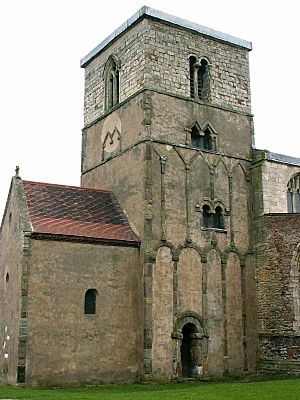Anglo-Saxon turriform churches facts for kids

Anglo-Saxon turriform churches were a special kind of church built a long time ago in England. This was during the Anglo-Saxon period. These churches were built in the shape of tall towers! You might also hear them called tower-nave churches.
Contents
What Were Tower Churches Like?
Many Anglo-Saxon churches were built as towers. The ground floor of the tower was used as the nave. This is the main part of the church where people gathered. A small room called a chancel usually stuck out from the east side of the tower. Sometimes, there was also a small room on the west side. An example is the baptistery at St Peter's Church, Barton-upon-Humber.
At St. Peter's Church, experts looked closely in 1898. They found old foundations showing where the first small chancel was. Marks on the tower's east wall also show its original size. It was narrower than the tower itself. Much later, around the 1300s, this chancel was replaced. A new, longer nave was built stretching east from the tower.
How Did These Churches Develop?
Some historians think that tower churches were the very first type of churches built in Anglo-Saxon England. This might have been especially true in smaller villages. It was easy to build with wood, just like other buildings. However, no churches are left today that are *only* a tower.
Experts suggest a possible way these churches changed over time:
- A small tower church was first built using timber (wood). It had a small eastern chancel. Sometimes, it also had a small "west-nave."
- Next, the chancel and west-nave (if it had one) were rebuilt using stone.
- Then, the ground floor of the tower itself was rebuilt with stone.
- Later, north and south wings were added to the tower. This made it look like a "winged square."
- Finally, a long nave was built. The tower then became just one end of the church, usually the west end.
However, this is just an idea. We only have one Anglo-Saxon timber church left, Greensted Church. We also have a few old written descriptions. And we have some clues from digging up old foundations. The stone churches we see today might have been built by carpenters. They simply used their wood-building skills with stone instead.
Inside the Towers
When experts studied these towers, they found much more wood inside than they expected. The tower of St Peter's in Barton-upon-Humber had three levels of timber (wood) structures:
- A first-floor gallery. This couldn't have been a solid floor. If it was, the ground-floor nave would only get light from the windows on the first floor.
- A belfry floor, where bells would have been.
- A wooden frame that held up the roof. This roof might have been stepped or a small spire.
Why Were They Built as Towers?
The three churches that are definitely known to have started as tower-naves are all in the Danelaw. This was an area in England where Vikings had a lot of influence. So, one idea is that they were built as towers for defence.
Historian John Blair suggests that the Earls Barton tower church was built by a powerful lord. It had lots of fancy decorations. He thinks it was meant to impress people. It also combined church, home, and defence uses. But, these towers had wooden floors. And they could be entered from both the nave and chancel. This would have made them very dangerous if Vikings attacked.
Another idea is that they copied churches from the Byzantine Empire. These Eastern Christian churches often had domes and a central plan. These could also be seen as tower-like buildings.
Surviving Tower Churches
Here are some churches that were originally towers:
Generally Accepted Examples
- St Peter's Church, Barton-upon-Humber, in Lincolnshire.
- All Saints' Church, Earls Barton, in Northamptonshire. This church had a chancel attached, but no western room.
- St Mary's Church, in Broughton, Lincolnshire. Later in the Anglo-Saxon period, a round stair tower was added to the nave-tower.
Later Norman Examples
Some churches built by the Normans (after the Anglo-Saxons) continued this style:
- St Bartholomew’s Church, Fingest, in Buckinghamshire.
- Church of St Simon and St Jude, East Dean, East Sussex. Most people think this one is Norman.
Similar Churches in Scotland
- Holy Trinity Church, Dunfermline. Old foundations show a two-room church under the nave.
- Abbey of St Peter, Restenneth.
- St Regulus' Chapel, St Andrews.
Gallery
-
Tower of All Saints' Church, Earls Barton




